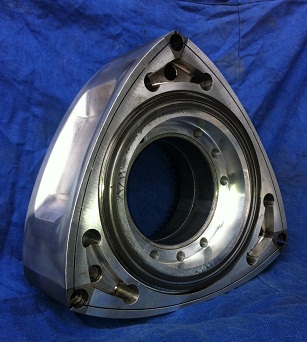Titanium rotors now running
#1
Titanium rotors now running
I'm not sure if this is the right place for this but this is a project I have been working on.
Billet Titanium rotors.
Hope you like the pictures.
The engine is now running and I have just completed 70 miles on it so far so it is early days yet.
They are running in an FD RX7 13B engine with major extend port and GT35r turbo at the moment.
Regards
Carl
Billet Titanium rotors.
Hope you like the pictures.
The engine is now running and I have just completed 70 miles on it so far so it is early days yet.
They are running in an FD RX7 13B engine with major extend port and GT35r turbo at the moment.
Regards
Carl
#4
I'm more interested in the performance gain and resistances to detonation/higher boost levels etc... Would be nice to be able to run 22-25 lbs and rev out till 9500 without worrying...
Trending Topics
#9
I see some holes underneath the rotor gear but I still have to ask, "Are you letting oil inside the rotor for cooling"? Also, is the oil jetting in from the center of the engine like a standard rotor or did you just say screw it? Why did you machine from the gear side?
#11
#13
First off, good job! I have been waiting for someone to start producing Ti rotors, and looks like you are well on the way!
Question: how are they cooled? Looks like you do not have interior oil bath like stock rotors. Any plans to measure temperatures at/near the apex seals?
RE: rotor housing comments: Titanium is a terrible material for rotor housings. It has a low thermal conductivity, so it will be harder to cool. More importantly, titanium is not a good friction material, as it tends to gall with any metal to metal contact.
Also, there is little weight savings possible as rotor housing strength is not a major issue, and the stock aluminum is quite light. Obviously there is also the cost issue as well.
Rotors, on the other hand, have a lot of room for improvement. Additionally, lightening rotors not only reduces overall weight, it reduces load on the eshaft, increasing power potential. Low TC is actually good in this case, as it removes less heat from the charge, increasing thermal efficiency. There is a design concern with the low TC, though, that it could created high metal temperatures at the apex/corner seal areas, resulting in failed parts. This is why I am surprised that this rotor seems to be designed to eliminate much of the stock oil cooling. The friction issue is also a concern with Ti rotors in that seals may become stuck in the grooves.
If these issues prove to be overcome with this design then I will buy a set!
Question: how are they cooled? Looks like you do not have interior oil bath like stock rotors. Any plans to measure temperatures at/near the apex seals?
RE: rotor housing comments: Titanium is a terrible material for rotor housings. It has a low thermal conductivity, so it will be harder to cool. More importantly, titanium is not a good friction material, as it tends to gall with any metal to metal contact.
Also, there is little weight savings possible as rotor housing strength is not a major issue, and the stock aluminum is quite light. Obviously there is also the cost issue as well.
Rotors, on the other hand, have a lot of room for improvement. Additionally, lightening rotors not only reduces overall weight, it reduces load on the eshaft, increasing power potential. Low TC is actually good in this case, as it removes less heat from the charge, increasing thermal efficiency. There is a design concern with the low TC, though, that it could created high metal temperatures at the apex/corner seal areas, resulting in failed parts. This is why I am surprised that this rotor seems to be designed to eliminate much of the stock oil cooling. The friction issue is also a concern with Ti rotors in that seals may become stuck in the grooves.
If these issues prove to be overcome with this design then I will buy a set!
#15
Bravo!
This charge cooling phase would be interesting to compare to the standard blank side rotor flow.
And probably this design would not play well with the side exhaust ports.
I'm In,
Barry
This charge cooling phase would be interesting to compare to the standard blank side rotor flow.
And probably this design would not play well with the side exhaust ports.
I'm In,
Barry
#20
Charge cooling would require significant other modification to the engine to create a flowpath for the air to flow through the rotor.
Also AFAIK, charge cooling severely limits MEP levels compared to oil cooling, and since I assume the point of this is to provide an increase in power, that doesn't seem like a good plan.
As stated, I really want this to work, but I was hoping for some explanation of the design...
Pat
Also AFAIK, charge cooling severely limits MEP levels compared to oil cooling, and since I assume the point of this is to provide an increase in power, that doesn't seem like a good plan.
As stated, I really want this to work, but I was hoping for some explanation of the design...
Pat
#24
Ultimately, a hardened steel or otherwise insert for the apex seal is quite the challenge.



